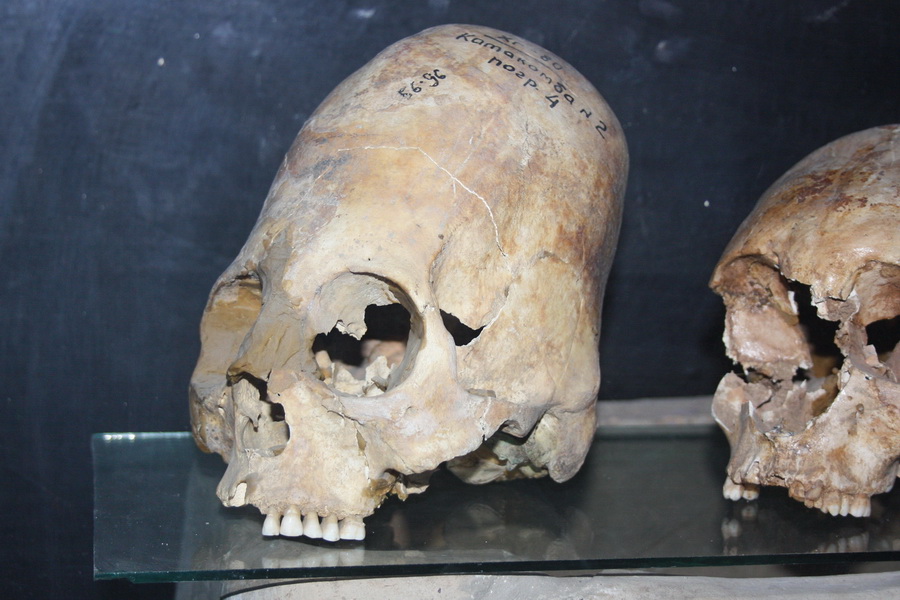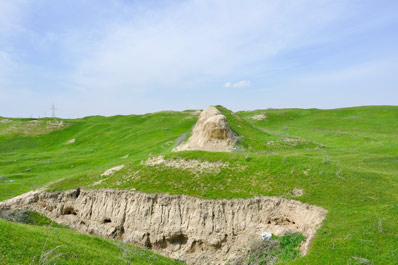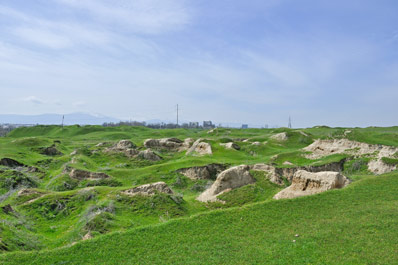Archeological discoveries of Uzbekistan

Archeology of Uzbekistan
The earliest evidence of human life in Uzbekistan dates back to the Stone Age, or middle paleolithic. These are petroglyphs, burials, and temporary settlements discovered by archeologists.
During the exploration of the mountainous area of Surkhandarya Region in 1931-48 archeologists found cave-dwellings of the ancient inhabitants of Southern Uzbekistan. The remains of a boy aged 8-9 who lived in the middle Paleolithic, and the skeleton of an adult Neanderthal man of the same epoch were discovered in 1938. A temporary settlement typical of the primitive hunters of the late paleolithic was found in Samarkand in 1939. Temporary settlements of ancient peoples of the late Stone Age and early Bronze Age were discovered in the sands of Karakalpakistan in 1937-47. The bones of a mammoth, ancient bull, horse, beaver, peat deer, and other ancient animals have been found in the desert and semi-desert areas of Tashkent Region, Khorezm, Turkmenistan, and Kazakhstan. The natural conditions of the ancient times were favorable for humans to settle the territory of Central Asia, which is confirmed by the remains of ancient dwellings and burials discovered in the Kyzyl-Kum and Kara-Kum Deserts.
According to the remains, the people living in the middle paleolithic hunted wild goats, leopards, wild boars, and other animals. These people also gathered the roots and fruits of wild plants. They used fire: hearths made of stone were found inside the dwellings. The men made their tools of stone using the split-off method, applied to siliceous limestone, quartzite, and jasper. Among these finds are stone plates, arrowheads, scrapers and axes, and wooden and bone articles. Bent skeletons encircled by goat horns and the like, found in graves, show how the thinking of the primitive men developed.
The temporary settlements discovered in Samarkand, and the petroglyphs in Shrabad and Machaiskaya Cave in Baisun District, as well as in many other regions of Uzbekistan are typical of the late Stone Age. At this time, sharp knife blades, various scrapers, drills, chisels, and arrowheads appeared, bones and horns began to be treated, and the bow and arrow were invented, as well as the awl and needle to make clothes from animal hides. The collection of fish-hooks found in the ancient settlement of Airtam in Surkhandarya Region and in the north Tashkent Canal are evidence of the beginning of fishing. Petroglyphs depicting human figures were also found in the Zaraut-Sai Gorge in Sherabad District of Surkhandarya Region.
The slightly baked earthenware discovered on the right bank of the Amudarya River, along the Unguz River, and in the northern part of the Kara-Kum Desert, the caves of Surkhandarya region, and the temporary ancient settlements in Tashkent, Samarkand, and Fergana Regions are evidence of the agriculture and crafts (pottery and sewing) developing in the late Stone Age.
The ancient houses were elliptical or multi-angular. They have been eroded by time as they were built out of wood and clay, with thatched roofs. However, there are remains of their foundations dated to the beginning of the 3rd millennium BC.
A temporary settlement, dated to the 3rd-1st centuries BC (Bronze Age) was discovered in 1945-46. Extensively developing agriculture and cattle-breeding as well as mechanization of labour began in the Bronze Age. According to Heroditus, who described this period, the Massagets made their weapons of copper or bronze, and jewellery - of gold. They didn't yet know of iron and silver. But the extraction of copper, founding of metals, and the jeweller's art were already developed.
Irrigation equipment and irrigation canal systems arose as agriculture developed. Domestic and foreign trade progressed. In Khorezm there was already a written language. The Iron Age (1st millennium BC - 1st century AD) is well-known thanks to archeological finds, as well as from literary sources of China, Greece, Iran, Syria, and other countries.
On the right bank of the Amudarya River, upstream from Termez, the sanctuary of the town of Airtam was created. A frieze decorating a Buddhist Sanctuary in the 1st century BC -1st century AD has also been found.
In the mountainous part of the Fergana Valley, archeologists have found burial constructions in the form of stone boxes. Articles dated to the period of the system of slavery were found on the right bank of the Amudarya River in 1970-80.
Are you interested in taking part in an archeological expedition and wish to live and work as archeologists do? We offer you our special Archeological tour Surkhandarya - a Cradle of Civilization.



